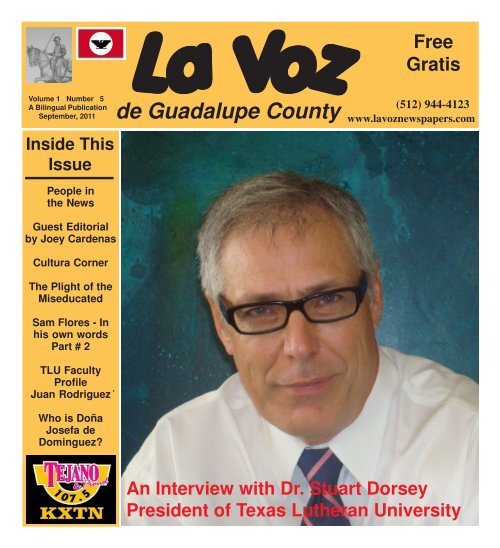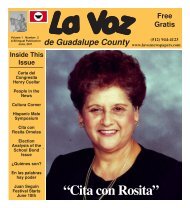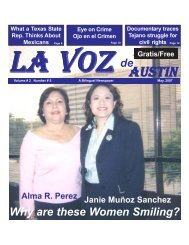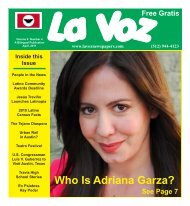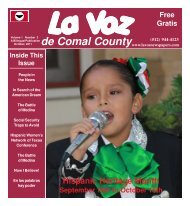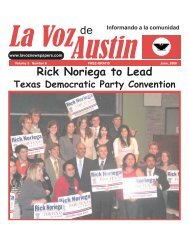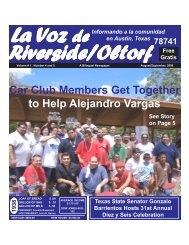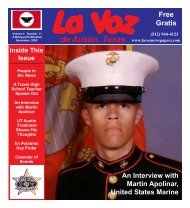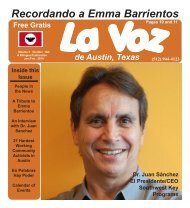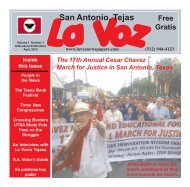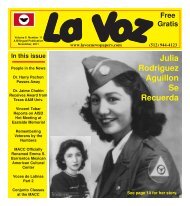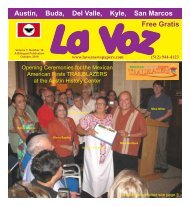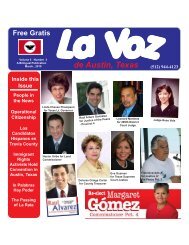La Voz de Seguin September 2011.pmd - La Voz Newspapers
La Voz de Seguin September 2011.pmd - La Voz Newspapers
La Voz de Seguin September 2011.pmd - La Voz Newspapers
- No tags were found...
Create successful ePaper yourself
Turn your PDF publications into a flip-book with our unique Google optimized e-Paper software.
Volume 1 Number 5A Bilingual Publication<strong>September</strong>, 2011Insi<strong>de</strong> ThisIssuePeople inthe NewsGuest Editorialby Joey Car<strong>de</strong>nasCultura CornerThe Plight of theMiseducatedSam Flores - Inhis own wordsPart # 2TLU FacultyProfileJuan RodriguezWho is DoñaJosefa <strong>de</strong>Dominguez?<strong>La</strong> V<strong>Voz</strong><strong>de</strong> Guadalupe CountyFreeGratis(512) 944-4123www.lavoznewspapers.com“Cita con Rosita”An Interview with Dr. Stuart DorseyPresi<strong>de</strong>nt of Texas Lutheran University
Page 2 <strong>La</strong> <strong>Voz</strong> <strong>de</strong> Guadalupe County - <strong>September</strong>, 2011Anna Maria ChávezSelected ChiefExecutive Officer ofGirl Scouts USAGirl Scouts of the USA (GSUSA)announced that Anna MariaChávez has been appointed to thetop post at the iconic organization.Chávez’s appointment as the 19thchief executive of Girl Scouts,among the largest and most wi<strong>de</strong>lyrecognized nonprofits in the country,comes as the organization readiesto launch a national celebration aspart of its 100th anniversary<strong>de</strong>signed to honor its legacy andcreate urgency around girls’ issues.“Girl Scouts is the premierlea<strong>de</strong>rship organization for girls witha trailblazing legacy that stretchesnearly 100 years,” said Chávez,who currently serves as chiefexecutive officer of Girl Scouts ofSouthwest Texas. “The countryhas never nee<strong>de</strong>d Girl Scouts morethan it does today. What girls areaccomplishing in Girl Scouting isinspiring. I have seen it firsthand inTexas, and I intend to tell that storyfar and wi<strong>de</strong>.”Chávez grew up in a Mexican-American family in the small townof Eloy, Arizona, and later inPhoenix. She holds a law <strong>de</strong>greefrom the University of ArizonaCollege of <strong>La</strong>w and a bachelor’s<strong>de</strong>gree in American history fromYale University. Bar admissionsinclu<strong>de</strong> the U.S. District Court for theDistrict of Arizona, ArizonaSupreme Court, and U.S. SupremeCourt. Her husband Robert is afinancial industry executive and theyhave a son, Michael.People in the NewsDr. Victor SaenzAddresses <strong>Seguin</strong>Rotary ClubDr. Victor Saenz, AssistantProfessor at The University ofTexas at Austin, addressed the<strong>Seguin</strong> Rotary Club on August30th, 2011. His talk focused on thenew <strong>de</strong>mographic reality of Texas(and the US), and how the growingUS <strong>La</strong>tino population provi<strong>de</strong>s evengreater urgency to the issues facing<strong>La</strong>tino males in education.Dr. Saenz also highlighted theimportant trends on educationalattainment for <strong>La</strong>tino males, andwhy it’s important to focus on andinvest in the education of the <strong>La</strong>tinopopulation, as our future economicprosperity is <strong>de</strong>pen<strong>de</strong>nt on thisgrowing community.A native of the Rio Gran<strong>de</strong> Valley,Dr. Saenz graduated from <strong>La</strong> JoyaHigh School in 1992, TheUniversity of Texas at Austin in1996 with a <strong>de</strong>gree in mathematics,the Lyndon B. Johnson School ofPublic Affairs at UT in 1999 with aMasters Degree and earned hisPh.D. from UCLA in 2005 in highereducation.Sandra TenorioElected Chair ofTejano DemocratsLongtime political activists, SandraTenorio of Buda, Texas waselected Chair of the state-wi<strong>de</strong>Tejano Democrats organization.She is the first female to hold thatposition in the organization’s history.Tenorio, who has also served asmayor of Kyle, has been a TejanoDemocrat member since theorganization’s founding in 1993, andhas served as chair and vice chairof the group’s Austin chapter. Shefollows former State Sen. GonzaloBarrientos as chair of the statewi<strong>de</strong>organization.Dr. Rogelio SaenzNamed New Deanat UTSAThe University of Texas at SanAntonio’s College of Public Policyis hosting a reception Tuesday,<strong>September</strong> 13th, 2011, at the PearlBrewery to welcome its new <strong>de</strong>an,Rogelio Saenz. The reception isfrom 5 to 7 p.m. at the AmericanInstitute of Architecture of SanAntonio at the Pearl, 200 E.Grayson St., Suite 110.Saenz, a sociologist and social<strong>de</strong>mographer, is originally from theRio Gran<strong>de</strong> Valley town ofMerce<strong>de</strong>s. He earned his bachelors<strong>de</strong>gree in 1981 from Pan AmericanUniversity, an Masters <strong>de</strong>gree inSociology in 1986 from Iowa StateUniversity and a Ph.D In sociology,also from Iowa State in 1986.Before coming to UTSA thissummer, he had been a facultymember at Texas A&M Universitysince 1986. Saenz replaces DennisHaynes, a professor of social work,who was interim <strong>de</strong>an of the publicpolicy school since 2008.Elida Reyna Wins atthe Tejano MusicAwards in SALong time Tejano singer Elida Reynatook home a bunch of awards fromthe30th Annual Tejano Music Awardsat the Municipal Auditorium in SanAntonio, Texas on <strong>September</strong> 10th,2011. A native of Merce<strong>de</strong>s, Texas,Reyna records with FreddieRecords out of Corpus Christi,Texas. This year she won, Song ofthe Year, Female Vocalist of the Year,Entertainer of the Year and Album ofthe Year.Celeste VillarrealElected to Post withHispanic NationalBar AssociationCeleste Villarreal, an Austinattorney, was elected Vice-Presi<strong>de</strong>nt of External Affairs for theHispanic National BarAssociation (HNBA) at their AnnualConvention in Dallas, Texas. TheHNBA is a national membershiporganization whose mission is torepresent the interests of the morethan 100,000 Hispanic attorneys inthe United States.Villarreal, who spent almost 25years working in the media,graduated from The University ofTexas at Austin in 1982 and earnedher law <strong>de</strong>gree from Texas TechUniversity in Lubbock, Texas in2005. In addition to her privatepractice she is also a part-timeMunicipal Judge for the city ofAustin.
PRODUCTIONEditor & PublisherAlfredo Santos c/sManaging EditorsYleana SantosKaitlyn Theiss<strong>La</strong> <strong>Voz</strong> <strong>de</strong> Guadalupe County - <strong>September</strong>, 2011State LULAC Director Provi<strong>de</strong>sUpdate on Redistricting <strong>La</strong>wsuitin San Antonio, TexasGuestEditorialPage 3MarketingRose Mary ZunigaJo Ann SutherlandDistributionEl TeamContributing WritersYvonne <strong>de</strong> la RosaFranco MartinezRichard G. SantosPUBLISHER’SSTATEMENT<strong>La</strong> <strong>Voz</strong> <strong>de</strong> GuadalupeCounty is a monthly publication.The editorial and businessaddress is P.O. Box19457 Austin, Texas 78760.The telephone number is(512) 944-4123. The use, reproductionor distribution ofany or part of this publicationis strongly encouraged. But docall and let us know what youare using. Letters to the editorare most welcome.Para cualquierpreguntallámenos291-9060944-4123The big enchilada is the best way to <strong>de</strong>scribe thetrial that is taking place in San Antonio, Texas.Nothing but the best that Texas’ <strong>La</strong>tino communityis fighting a battle royal against the State of Texasin the fight to redistrict Texas after the 2010 census.From 2000 to 2010, Texas population grew from20,581,763 to 25,373,947, an increase of 21.68%,Whites increasing from 11,074,619 to 11,441,991,an increase of 3.32 %, Blacks increasing from2,421,693 to 2,925,751 an increase of 20.81%, and<strong>La</strong>tinos (Hispanics) from 6,669,666 to 9,847,852,an increase of 47.65%.From 2000 to 2010, Whites accounted for 7.67%of the new population growth in Texas, whileminorities accounted for 92.33% in growth in Texas.<strong>La</strong>tinos accounted for 66.32% of the total growth.According to provisions in several sections of theU.S. Constitution, census are to be taken every10 years and based on the census, states are reapportionedCongressional seats based on thepopulation of each state. The number ofCongressional seats is fixed at 435. These 435seats are re-apportioned based on the census countevery 10 years.In this year’s census, Congressional seats werere-apportioned, giving Texas 4 new congressionalseats, that is, 4 new Congressional districts, Florida2, Arizona, Georgia, Nevada, South Carolina,Utah and Washington, 1 each, Illinois, Iowa,Louisiana, Massachusetts, Michigan, Missouri,New jersey and Pennsylvania, each lost 1 andNew York and Ohio lost 2.The United States Senate always stays at 2 USSenators per state, but the Congressional seats,while remaining fixed at 435, the number per stateis apportioned according to populations shifts ineach state. Well, Texas has the hard task ofreapportioning, reconfiguring, its 32 Congressionaldistricts it garnered in 2010 to 36, the new numberbased on the 2010 census. In other words, Texasremaining the same size physically, needs to redrawits Congressional lines to fit 36 Congressional seatsinto the same area that accommodated 32Congressional seats in the past.The name of the game in reapportioning is redistricting.In states throughout the country, there-districting of Congressional districts inclu<strong>de</strong>sre-districting of most political electoral lines, fromCongressional districts, to state senatorialdistricts, to state legislative districts, to schoolboard districts, to county precincts, to constabledistricts, to city council districts.One of the first lawsuit to make it to court wasthe Teuber v. Texas case which was filed byRepublican Tea Party activists. Their argumentcentered on the i<strong>de</strong>a that any redistricting thatrelied on illegal immigrants in the census countshould not be permitted, that is, should be barred.The problem with this argument was who is theillegal population in Texas? The other logicalargument was, how was it that Texas got 4 newCongressional districts, where illegals wereinclu<strong>de</strong>d in the count and how was it that theplaintiffs now wanted to not count them? TheTeuber lawsuit was non-suited, that is, dismissedfrom the court docket.Three other lawsuits were consolidated on July6, 2011 by the fe<strong>de</strong>ral district court judge assignedto the case in San Antonio, Judge OrlandoGarcia, and are known respectively as the Perezcase, the Mexican American LegislativeCaucus, Texas House of Representatives(MALC) case and the Texas <strong>La</strong>tino RedistrictingTask Force. The <strong>de</strong>fendants in each case areRick Perry as Governor of Texas and other Stateofficials. The lawsuits are challenging Texasredistricting that were drawn up by Republicancontrolled committees and legislatures that drewup Texas new Congressional districts in ways thatdid not give minorities who accounted for themajor population gains in Texas and rewar<strong>de</strong>dtheir White political districts. The end result wouldbe Congressional seats and other political districtsin Texas that would not reward the minoritycommunities of Texas which is the growthJoey Car<strong>de</strong>nas IIILULAC - State Directormachine for Texas’ population. <strong>La</strong>tinosincreased from 2000 to 2010 by 47.65%,Blacks by 20.81% and Whites by 3.32% andWhites become the gaining community inTexas political redistricting.National LULAC did not want Texas LULACto join in the Texas fight. National had a plan,but weren’t telling anyone. The threat fromLuis Vera, LULAC’s acting NationalPresi<strong>de</strong>nt, actually legal advisor, to TexasLULAC was to stay out of the redistrictingfight or face expulsion from LULAC. TexasLULAC went around National LULAC andjoined up with the Texas <strong>La</strong>tinoRedistricting Task Force. National LULAChas intervened as a third party plaintiff(petitioner) in the Mexican AmericanLegislative Caucus.The trial of the consolidated case startedin San Antonio on <strong>September</strong> 6th and thecast before the court were among the mostrespected people in Texas, including, JoeBernal, Alex Jimenez, Dr. Andres Tijerina,Dr. Henry Flores, all who testified today aswell as some redistricting experts before the3 Fe<strong>de</strong>ral Judge Panel. The trial is expectedto last until <strong>September</strong> 16th.
Page 4<strong>La</strong> <strong>Voz</strong> <strong>de</strong> Guadalupe County - <strong>September</strong>, 2011Yvonne De <strong>La</strong> RosaTeatro Program Coordinator“In Search of the American Dream” is the story about four children and their adultbrother as they <strong>de</strong>sperately race across Texas for survival. They are running becausetheir parents, undocumented for 30 years, were caught, arrested and thrown in jail in onefell swoop. Deportation is only a matter of time. When CPS separates them, the childrenare forced to abandon the only home they’ve ever known, leaving behind their friends,their school, neighbors, sweethearts and their youngest brother, age 3, and their dog,Frijol.A routine traffic stop by a police officer goes terribly wrong and now they are not onlyrunning from immigration officers but also from the law.If forced, what would you do to keep your family together? Learn about the Martinez’sand their heralding journey to <strong>de</strong>al with the issues that threaten to tear their family apart.“In Search of the American Dream” will grip you and your family. Journey with the Martinezfamily as they face a challenge beyond their worst fears. This movie will make you loveyour family even more.In the United States we see media coverage of huge “immigrant roundups” (raids) butthe story of what happens to children who are torn from their parents when the parentsare <strong>de</strong>ported is rarely seen. Yet it happens every day in this country. The present law mustbe enforced. The parents must go but the American-born children stay.“In Search of the American Dream” tells the story of one family torn apart… and thefear and agony the children are forced to bear alone.“In Search of the American Dream” is currently in post-production and is slated to bereleased in early 2012Welcome to the <strong>September</strong> edition of“Cultura Corner.” The fall is an exciting monthas we celebrate some profound and <strong>de</strong>finingevents. Can you name one or two?The first event is the Hispanic HeritageMonth (<strong>September</strong> 15 – October 15) that iscelebrated to recognize the contributions thatHispanic Americans have ma<strong>de</strong> to Americansociety and culture. In the spirit of Teatro’smission and goals, we celebrate thecontributions that Mexican-Americans havema<strong>de</strong> to our local, state and nationalcommunities. This event also honors five ofthe Central American neighbors whocelebrate their in<strong>de</strong>pen<strong>de</strong>nce during themonth of <strong>September</strong>.National Hispanic Heritage Month had itsorigins in 1968 when Congress passed Pub.L. 90-498 (PDF, 153 KB), which authorizedand requested the Presi<strong>de</strong>nt to issue anannual proclamation <strong>de</strong>signating the weekincluding <strong>September</strong> 15 and 16 as NationalHispanic Heritage Week. During that weekHispanic American celebrated anniversariesof in<strong>de</strong>pen<strong>de</strong>nce for <strong>La</strong>tin American countriessuch as Costa Rica, El Salvador,Guatemala, Honduras and Nicaragua thatfalls on <strong>September</strong> 15 th , Mexico’sin<strong>de</strong>pen<strong>de</strong>nce on <strong>September</strong> 16 th , and Chile’son <strong>September</strong> 18th. The first proclamationwas issued by Presi<strong>de</strong>nt Lyndon Johnson.In 1988, Presi<strong>de</strong>nt Ronald Reaganexpan<strong>de</strong>d the weeklong celebration to onemonth. The month long celebration nowinclu<strong>de</strong>s Columbus Day or Dia <strong>de</strong> la Raza,which is October 12 th .At the National/International levels, wecelebrate: Ellen Ochoa-World’s FirstHispanic Female Astronaut, Frida Kahlo-Mexican Artist, Rita Moreno & AnthonyQuinn-Performers, Sandra Cisneros &Octavio Paz-Writers, Cesar Chavez &Dolores Huerta-Political Figures, JaimeEscalante-Educator, Sonia Sotomayor-FirstHispanic U.S. Supreme Court JusticeAt the local level, we celebrate the manyindividuals who have consistently contributedto making this community a better place tolive in. These individuals (the list is not acomplete list) have supported and ma<strong>de</strong>valuable contributions to the educationalsystem as well as to the cultural arts. Theyare: Dr. Irene Garza; Mary Martinez; Dr.Maria Avalos; Sam Flores; Liz Campos;Alphonso Rincón; Homer and Vickie De <strong>La</strong>Rosa; Alejandro & Yolanda Guerra; MariaG. Betancourt; Yomeida Guerra; GloriaReyna; Gilbert, Dolores & Michelle Avalos;Nick & Velma Carrillo; Cresencio & FrancisPerez; Dr. Rachel Cruz; Johnny & MaryCruz; Rose Medrano; Steve & EstherBoehm; Gilbert & Glenda Moreno; RenéMoreno; Ricardo & Janie Guerra; SamRamos; Stella Ozuna; Dr. Soledad Ramirez;George and Isabel Cabello Start; Gloria,Ellie and Janie Jimenez; Johnny, Maggie& Ashley Gonzales; Robert & Dora Luna;Mary Louise Ludt; Shaun Val<strong>de</strong>z; JerryBelmarez, … This is just to name a few! I willcontinue the list in future articles.In the spirit of celebration and recognition,I invite you to visit Teatro’s GALERIA (ExhibitRoom). We have a Hispanic Heritage Monthdisplay that inclu<strong>de</strong>s photos, paper clippingsand other media of local Hispanics who havecontributed to the Mexican-American arts,culture, traditions and education. The displaydates back to 1982.The second event is the Diez y Seis <strong>de</strong>Septiembre Celebration which is Mexico’sIn<strong>de</strong>pen<strong>de</strong>nce from Spain. Did you know thatin the early hours of <strong>September</strong> 16, 1810—on the church steps in the town of DoloresHidalgo, Father Miguel Hidalgo y Costillarang the church bell to gather all the towns’people? On that evening, he read the Grito<strong>de</strong> Hidalgo. In the Grito he asked thateveryone rise up against the Spanish Crownwhich launched the Mexican War ofIn<strong>de</strong>pen<strong>de</strong>nce from Spain. The countryfought long and hard but did not achievein<strong>de</strong>pen<strong>de</strong>nce until 1821. It is important toremember that we celebrate the Diez y Seis<strong>de</strong> Septiembre to commemorate the braveryand perseverance of our ancestors, the fightto preserve their cultural i<strong>de</strong>ntity, and the willof a community to stand up for an i<strong>de</strong>a biggerthan themselves: In<strong>de</strong>pen<strong>de</strong>nce.
<strong>La</strong> <strong>Voz</strong> <strong>de</strong> Guadalupe County - <strong>September</strong>, 2011Page 5THE PLIGHT OF THE MISEDUCATED:IN SEARCH OF AN IDENTITYI used to tell my stu<strong>de</strong>nts and now tellaudiences when the occasion arises, that U.S. history is written and taught in black andwhite images from the East Coast and eastof the Mississippi. This automatically meansthat the anti-Spanish, anti-MediterraneanBlack Legend is subtlety taught to stu<strong>de</strong>ntswho do not know they are being brain washed.Without them knowing, they are miseducatedto believe that everything Spanish,Mediterranean and Roman Catholic is inferiorto the White Anglo Saxon Protestant(WASP) culture. The history text books reflectthis approach as all Spaniards are <strong>de</strong>pictedas blood thirty, gold hungry, mur<strong>de</strong>ringCatholics who killed and/or enslaved theNative American cultures.The textbooks and WASP perspective onhistory, never teach or discuss Spanishlegislation such as <strong>La</strong>s Nuevas Leyes of the1540’s or the more important Recopilacion<strong>de</strong> Leyes <strong>de</strong> Indias of the mid 1600’s, thatrecognized the civil rights of the NativeAmericans as citizens of the Spanish Empire.Other than listing and illustrating thetextbooks with photographs of the Franciscanmissions, the textbooks never discuss theevangelization program of the SpanishCatholic Church and the Religious Or<strong>de</strong>rs (ie.Franciscans, Dominicans, Jesuits et. al.)who through bilingual education assimilatedmany Native American cultures to SpanishNorth American society.Simply put, at one point a Spanishspeaking Native American was baptized aCatholic, given a Spanish name, and sociallytransferred from being consi<strong>de</strong>red agovernment protected neophyte to a Spanishcitizen. Once assimilated, the Spanishspeaking, Roman Catholic Native Americanhad all civil and religious rights within Spanishsociety.The socio-political-economic limitationsexperienced by the assimilated NativeAmericans were ruled by the Spanish castesystem. Both Spanish Church and Statei<strong>de</strong>ntified 28 social castas with the Spanishborncitizen at top of the social structure. Theywere called Gachupin. Spanish citizens bornon the Iberian peninsula (ie. Spain, Portugal,Viscaya, Navarre, Provance, Galicia) werecalled “peninsular”. These first two groupsrepresented the ruling class of the SpanishEmpire. They were the viceroys, generals,admirals, archbishops, bishops and religiousmissionaries who tried their best to enforceSpanish law and policy.A person born in the New World ofEuropean stock without Native American,Asian or Black ancestry were calle<strong>de</strong>spanoles or criollos. They were the secondclass citizens of the Spanish Empire. As suchthey were the military officers from coloneldown to alferez (lieutenants), vicars,monsignors,parish priests,l o c a lmerchants,cattle barons,hacendados(large propertyowners) an<strong>de</strong>ncomen<strong>de</strong>roswho were vastpropertyo w n e r scharged withthe protection,maintenanceBy Richard G. Santosrichardgsantos@yahoo.comThey were the second classcitizens of the Spanish Empireand religious instruction of the NativeAmericans on their estates.The founding families of townships andcommunities of Nuevo Leon, Coahuila,Tamaulipas and South Texas wereespanoles and criollos of Spanish-Portuguese-Italian Sephardic Jewish,Basque, as well as <strong>de</strong>vout “Old Christians”and converso “New Christians” ancestry. Theonly exception were the 15 families (59people) from the Canary Islands whofoun<strong>de</strong>d the Villa San Fernando <strong>de</strong> Bexar(now San Antonio) in 1731. However, theythemselves were of Sephardic, Old Christianand New Christian background.The children of a union of aEuropean and Native Americanwere the third class citizens.The children of a union of a European andNative American were the third class citizens.Originally (1500’s to mid 1600s) if the fatherwas of European stock and the mother NativeAmerican, the children were called“castizos”. If the father was Native Americanand the mother of European ancestry, thenthe children were called “mestizo”.By the late 1600’s the term and social<strong>de</strong>signation of castizo was dropped and allchildren of such unions are commonlyreferred to as mestizos. This was probablybrought about by the marriages of castizosand mestizos which did not produce analternate social i<strong>de</strong>ntification tag. This socialc a s t arepresentedt h emajordomos,c l e r k s ,domestics,ranch hands,cattle hands,farmers,masons, andlocal militiamembers.The fourthclass castawere the Native Americans divi<strong>de</strong>d into twogroups. First and foremost were the Spanishspeaking,Roman Catholic, “mission Indians”and their land-owning <strong>de</strong>scendants. Theyrepresented the manual intensive labor forceof the Spanish American colonies.The totally assimilated Native Americans(such as the Tlaxcaltecans) were usuallyreferred to as “gente <strong>de</strong> razon” as they werefrequently employed as colonists in new areasto serve as an example to the local NativeAmericans of the benefits of becoming aSpanish-speaking, Roman Catholic, landowningperson who dressed and lived liketheir mestizo and criollo neighbors. The 200Tlaxcaltecans who foun<strong>de</strong>d San Esteban <strong>de</strong>Tlaxcala opposite the river from Saltillo,Coahuila in 1598 are a good example. Someof their <strong>de</strong>scendants were among the settlersof the third founding of Monclova, Coahuilain the 1680s and the original Villa <strong>de</strong> Bexar in1716 - 1718 (now San Antonio, Texas).Not all Native Americans went through themissions. On October 12, 1837, JoseFrancisco Ruiz presented a Resolution to theSenate of the Republic of Texas stating “thepeople called Lipan (Apache), Karankawa(Texas Gulf Coast) and Tonkowa (southcentral Texas from Waco to Atascosa,Wilson, Medina and Frio counties) yourcommittee consi<strong>de</strong>rs part of the MexicanNation and are no longer to be distinguishedfrom that Nation. They occupy the westernpart of Texas”.In 1837, “West Texas” began at theColorado River and exten<strong>de</strong>d to the RioGran<strong>de</strong>. Hence, the Native Americans familyclans of diverse tribes and nations not killedby the recently arrived settlers from the UnitedStates, were socially and legally <strong>de</strong>clared“Mexican” but not Mexican citizens. Manyeventually moved into the communities ofSouth Texas where in time they became partof the Tejano and Mexican Americanpopulation.It is unfortunate that the standard U. S. andTexas history textbooks do not inclu<strong>de</strong> anyof this historical information and insights as itis very important to un<strong>de</strong>rstanding the culturaldiversity of the Tejano and MexicanAmerican population of South Texas. Notknowing any of this and brainwashed with theWASP Black Legend version of U. S. andTexas history, many reach out for a falsei<strong>de</strong>ntity they consi<strong>de</strong>r more positive than theircultural i<strong>de</strong>ntity, or succumb to an inferioritycomplex due to not knowing their respectivefamily background.This article was first published in the ZavalaCounty Sentinel ………31 August – 1 <strong>September</strong>2011
Page 6<strong>La</strong> <strong>Voz</strong> <strong>de</strong> Guadalupe County - <strong>September</strong>, 2011An Interview with<strong>La</strong> <strong>Voz</strong>: Welcome to Texas Dr.Dorsey. Let’s start this interviewby sharing with our rea<strong>de</strong>rs a littleof your early background. Tell usif you would about your earlyeducation, where you grew upand what high school was like foryou.Dr. Dorsey: I was born andraised in Redfield, SouthDakota, pop. 3000. High schoolin South Dakota in the 1960swas pretty simple, and we hadmuch less to <strong>de</strong>al with thantoday’s young people. I kept busyplaying football, basketball andgolf. I had teachers and coachesthat had a big impact on me. Myparents both were musicians, sothat also was a big part of myearly life.<strong>La</strong> <strong>Voz</strong>: When you think back tothe time when you were gettingready to graduate from highschool, what was going on in yourtown? What were young peoplethinking about, talking about?As I was getting readyto graduate in 1969 , thebiggest thing on ourminds was the warin VietnamDr. Dorsey: Things were prettyquiet in Redfield; again a verysmall town. There was not a lotof opportunity to get into trouble.No drugs or gangs. Everyoneknew everyone else, so youcouldn’t hi<strong>de</strong>. As I was gettingready to graduate in 1969 , thebiggest thing on our minds wasthe war in Vietnam. All of usexpected to be drafted, andwould likely would be sent toSoutheast Asia. We all knewol<strong>de</strong>r brothers or friends who diedthere, so that hung heavy overall of our heads during my timein high school. Every generationha its own unique bur<strong>de</strong>ns tocarry- that was ours.<strong>La</strong> <strong>Voz</strong>: How was it that youchose to enroll at the Universityof South Dakota?Frankly, I never reallythough of lookinganywhere else.Dr. Dorsey: Frankly, I neverreally though of looking anywhereelse. It was where my ol<strong>de</strong>r sisterand brother went, plus, it had thebest school of business in thestate. College selection was verydifferent back then. Schools werenear capacity and there was notthe kind of extensive searchingthat stu<strong>de</strong>nts and parents donow. Almost all of my classmateswere first-generation collegestu<strong>de</strong>nts, and were just glad toget in somewhere.<strong>La</strong> <strong>Voz</strong>: After graduating fromcollege did you go to work or didPresi<strong>de</strong>nt of Texasyou head straight for graduateschool?Dr. Dorsey: I went directly tograduate school at WashingtonUniversity in St. Louis. I knewwhat I wanted- to get a Ph.D. ineconomics- so there was noreason to <strong>de</strong>lay starting mycareer. I love St. Louis, and I hadwork for the U.S. SenateCommittee on Finance as staffeconomist. That was an excitingtime for a young economist, asthe Finance Committee hadjurisdiction over fe<strong>de</strong>ral tax policyand all of the entitlement<strong>La</strong> <strong>Voz</strong>: What lessons did youlearn from your time at theUniversity of the Redlandswhich will help you in guidingTexas Lutheran University?a great experience at programs. It was a privilege toWashington U.<strong>La</strong> <strong>Voz</strong>: Somewhere I read thatyou worked for the U.S.work for Senator Bob Dole, andI stayed there three years.Valuable lessons? I learned towrite well, write quickly and workThere is a steeplearning curve for a newcollege presi<strong>de</strong>nt . . .Department of <strong>La</strong>bor: What with <strong>de</strong>manding, highly Dr. Dorsey: There is a steepwas that experience like andwhat was the most valuablelesson you took away?intelligent, but often difficultpeople.learning curve for a new collegepresi<strong>de</strong>nt, so I’ve been able tomove much more quickly to be astrong lea<strong>de</strong>r here at TLUAfter teaching full timefor three years aftergraduate school, I had anopportunity to go to D.CDr. Dorsey: After teaching fulltime for three years aftergraduate school, I had anopportunity to go to D.C. and dofull-time research on privatepensions. That was a valuabletime, but frankly, coming intowork everyday and grinding awayby myself was getting tedious. Imissed the stu<strong>de</strong>nts. Fortunately,I had the unique opportunity to“Things were pretty quiet inRedfield; again a very smalltown.”“I loved pheasant dinners as achild, and I would have to saythat it still is my favorite.”
<strong>La</strong> <strong>Voz</strong> <strong>de</strong> Guadalupe County - <strong>September</strong>, 2011Page 7Dr. Suart DorseyLutheran UniversityRich). As I get ol<strong>de</strong>r, I like to listento quieter “smooth” Jazz. My kidscall it elevator music.because of my previousexperience. I have a sense ofconfi<strong>de</strong>nce, tempered byun<strong>de</strong>rstanding about what worksand what does not on collegecampus. I think I have aparticularly good grasp on theeconomic challenges facinghigher education.<strong>La</strong> <strong>Voz</strong>: What is the mostchallenging aspect of <strong>de</strong>velopingan endowment fund at a privateuniversity?“So we have to work har<strong>de</strong>r atgetting Hispanic stu<strong>de</strong>nts toconsi<strong>de</strong>r us.”Dr. Dorsey: Absolutely the keychallenge is articulating anexciting vision for the university’sfuture. Without that, there is noreason for an individual to makea financial commitment. Youhave to give them an emotionalstake in bringing aboutsomething exciting andtransformational. When you canpaint that picture, askingsomeone for a seven-figure giftis not difficult- it’s fun.<strong>La</strong> <strong>Voz</strong>: While you have onlybeen here a short time, is it yoursense that the challenges ofgetting Hispanics enrolled incollege, the same as they wereor are in California?Hispanic stu<strong>de</strong>nts tendnot to think about small,private colleges, and ifthey do, they think thatthey would not fit in tothe campus cultureDr. Dorsey: I think they aresimilar. We had good success inCalifornia, but we had to workhar<strong>de</strong>r. Hispanic stu<strong>de</strong>nts tendnot to think about small, privatecolleges, and if they do, they thinkthat they would not fit in to thecampus culture. So we have towork har<strong>de</strong>r at getting Hispanicstu<strong>de</strong>nts to consi<strong>de</strong>r us, but alsobe mindful that the normaladjustment process for afreshman stu<strong>de</strong>nt may be thatmuch har<strong>de</strong>r. But we are verygood at this.TLU always had been aboutopening doors of opportunity,often for first-generationstu<strong>de</strong>nts, welcoming stu<strong>de</strong>ntsfrom diverse backgrounds, andworking hard to give them thetools to succeed. There is afamily approach here thatresonates well with Hispanicstu<strong>de</strong>nts.<strong>La</strong> <strong>Voz</strong>: Again, I know you haveonly been here a short time, butwhat would you say are the topthree things you will be focusingyour attention during your firstyear here?Dr. Dorsey: First, raising thevisibility and awareness of TLU.Won<strong>de</strong>rful things happen here;lives are transformed, and yet wetend to be un<strong>de</strong>r the radarscreen. Fund-raising also will beimportant, as we have importantinvestments to make into ourcampus and programs. But mostimportantly, all of us at TLU willcontinue to focus on <strong>de</strong>livering agreat experience for ourstu<strong>de</strong>nts. Our primary goalalways must be to raise the valueof a TLU <strong>de</strong>gree.<strong>La</strong> <strong>Voz</strong>: Let’s conclu<strong>de</strong> thisinterview by asking you somedifferent kinds of questions.What is your favorite food?Redfield, S.D. is the“Pheasant Capital of theworld,” so we all had afreezer full of wildpheasant.Dr. Dorsey: Redfield, S.D. is the“Pheasant Capital of the world,”so we all had a freezer full of wildpheasant. I loved pheasantdinners as a child, and I wouldhave to say that it still is myfavorite.<strong>La</strong> <strong>Voz</strong>: What kind of music doyou like to listen to?Dr. Dorsey: Not very Texan I’mafraid. My parents had a danceband for years, so my taste runesto swing (Frank Sinatra),Dixieland (Pete Fountain), andcontemporary big band (Buddy<strong>La</strong> <strong>Voz</strong>: Well, Dr. Dorsey, wewant to thank you for taking thetime to visit with us. We lookforward to working with you asyou take Texas LutheranUniversity to the next level.Dr. Dorsey. Thanks to <strong>La</strong> <strong>Voz</strong> forhaving me, and good luck to youand your rea<strong>de</strong>rs.ABOUT TLUTexas Lutheran Universitystu<strong>de</strong>nts experience achallenging aca<strong>de</strong>micenvironment that sets a path forlifelong learning. Our stu<strong>de</strong>ntsengage in high impacteducational experiences thatinclu<strong>de</strong> civic engagement,aesthetic expression, criticalthinking, and a focus onintercultural and globalknowledge in a community thatwelcomes the interplay of faithand reason.Foun<strong>de</strong>d in 1891, TexasLutheran resi<strong>de</strong>s on 184 scenicacres in <strong>Seguin</strong>, Texas, near SanAntonio and Austin. A diversestu<strong>de</strong>nt body of approximately1,400 with classes averagingfewer than 20 stu<strong>de</strong>nts provi<strong>de</strong>sa sense of community and anenvironment where individualityand personal growth are asintegral to success as rigorousaca<strong>de</strong>mics.
Page # 8 <strong>La</strong> <strong>Voz</strong> <strong>de</strong> Guadalupe County - <strong>September</strong>, 2011Hispanic Community in <strong>Seguin</strong>Celebrates 16th of <strong>September</strong> in 1944In 1994, AlphonsoRincon was publishing anewspaper called TheCasa Blanca Review. Inhis <strong>September</strong> issue for1994, he ran the photo onyour left of a 16th of <strong>September</strong>celebration in<strong>Seguin</strong> that took place in1944.Like many MexicanAmerican communities inTexas, cultural celebrationshave been takingplace for over a hundredyears. What is significantabout these celebrationsis that they served to reminda community thatthere is a history rich in traditionthat should not beforgotten.En 1994, AlphonsoRincon estaba publicandoun periodico llamada TheCasa Blanca Review. Enel ejemplar <strong>de</strong> septeimbre<strong>de</strong> 1994, publicó el foto amano izquierda <strong>de</strong> un festival<strong>de</strong>l 16th <strong>de</strong>septiembre que se llevoacabo en en <strong>Seguin</strong> en1944.Como muchascomunida<strong>de</strong>s MexicoAmericanas en Texas, <strong>La</strong>Raza tiene más <strong>de</strong> cienaños celebrando su culturaly historia.MR. G.Bail Bonds24-HOUR SERVICE108 North River<strong>Seguin</strong>, Texas 78155ARMANDO (MANDO)GONZALES(830) 303-2245 Office(800) 445-0778 Office
<strong>La</strong> <strong>Voz</strong> <strong>de</strong> Guadalupe County - <strong>September</strong>, 2011Page # 9Mickey y sus CarnalezSaturday, October 8th, 20118:00pm to 11:00pm at the Dance PavilionPresented by <strong>Seguin</strong> LULAC Council 682Tickets are $12 Pre-Sale $15 at the door Tickets available at JP’s Quik Stop & Bakery and theGuadalupe County Fair Association office. Tickets are also availabe from any LULAC memberTambién Tocando: Conjunto RomoEnd of the TrailMassage Therapy And ReflexologyMrs. Judy A. Leath, LMT200 N. River StreetSuite 100 F 1 hour - $50<strong>Seguin</strong>, Texas 78155 ½ hour - $30Mon-Wed-FriBy appointment onlyCall and leave message(830) 305-3637Tuesdays only$8.00Senior Hair Cuts 65 and ol<strong>de</strong>rTue-Fri 9-5 Sat: 9-4Haircuts for Women, Men andChildren. Color, Perms, Etc.(830) 372-13271650 N. Austin<strong>Seguin</strong>, Texas
Page 10<strong>La</strong> <strong>Voz</strong> <strong>de</strong> Guadalupe County - <strong>September</strong>, 2011Part 2The following is part of anautobiography that Mr.Flores started to write a yearago upon the invitation of Dr.Ana Maria Gonzalez. Thework will be part of the“<strong>Seguin</strong> Stories” project thatshe has been leading atTexas Lutheran University.One moretry at college“I enrolled in the secondsummer session again atSouthwest Texas TeachersCollege. My father hadremarried and my brothers andsisters were doing well. I startedto get more involved in thechurch and soon had the positionof master of ceremonies.”“One Sunday I noticed mysister, who lived in <strong>Seguin</strong> hadbrought a new friend to church.After the services were over, Iwent over to talk to Francis andshe introduced me to her friend,Velia Garcia. As it turned out,they worked together at thePalace Theater in <strong>Seguin</strong>.Francis worked a ticket cashierand Velia worked in the office asa secretary. We spoke brieflyand then they left for lunch at alocal restaurant.Before they left, I told Francisto invite Velia to come again tothe church. They returned thefollowing Sunday. After theservice I invited Velia to havelunch with me. She agreed andwe went to a nice MexicanRestaurant called Alex Café.Se va casar SamDuring lunch we became moreacquainted and I asked her if Icould see her again. She said yesand I started going to <strong>Seguin</strong> tosee her. Most of the time we wentto the movies and then we wouldgo out for a snack or dinner. Afterseveral times meeting with hershe said she wanted me to go toher home and meet her parents.I said I appreciated the invitation.The following week I went toher home and she introduced meto her mother Elvira and herfather Bartolo. They welcomedme and were very cordial. Theyinvited me to stay for dinnerwhich I did. There after we metregularly and several monthslater I asked her if she would bemy girlfriend. Again, she agreedand several months after that Iasked her if she would marry me.In His Own WordsSam and Velia on their wedding day December 20, 1953She said she would have tospeak to her parents. A weeklater she told me that her parentshad agreed so I ma<strong>de</strong> plans togo and ask them in person forpermission to marry theirdaughter.Se casó SamAfter a discussion to know mebetter and what my plans werefor the future, they agreed to forus to be married. We set the dayof our marriage on December 20,1953. I was still a stu<strong>de</strong>nt incollege but several monthsbefore our marriage I rented ahome in San Marcos. I boughtnew furniture on credit. I ha<strong>de</strong>verything ready for us to movein after our marriage. We weremarried at <strong>La</strong> TrinidadMethodist Church in <strong>Seguin</strong>,Texas with the ReverendEugenio Vidaurri officiating.After the church wedding PhilMedlin escorted us back to mywifes’s house where we hosteda small reception. I borrowed myfather’s car and Velia and I wentto Austin overnight for ourhoneymoon. Wereturned the followingday and went to ourhome which I hadrented. For the firstseveral month Veliawas at home as ahouse wife and wewere barely making it.We were living on thesmall subsistence thatthe government un<strong>de</strong>rthe GI Bill wasproviding. She saidshe nee<strong>de</strong>d to work tohelp out and managedto get a job in <strong>Seguin</strong>at the <strong>de</strong>ntal office ofFreddie Sagabiel.She commuted to<strong>Seguin</strong> by Greyhound Bus andreturn to San Marcos in theafternoon.On May 9 th , 1955 I graduatedfrom Southwest TexasTeacher College. I had earneda bachelor’s <strong>de</strong>gree in educationwith a minor in art. I hadcompleted college in three yearsgoing full time including allsummer sessions.During the three years I hadonly one failing course whichwas a “D” that I ma<strong>de</strong> ingeography. Most of my gra<strong>de</strong>swere C with some B’s, but notone single A. My wife, her familyand I atten<strong>de</strong>d the graduationexercise on campus. I was veryhappy and looking forward to thefuture and getting a teaching job.I went to look for a job in<strong>Seguin</strong> and filled out anapplication. I was told to go tothe Juan <strong>Seguin</strong> ElementarySchool which was fullysegregated from gra<strong>de</strong>s 1-6.The school was called theMexican School. This is whenI found out that the <strong>Seguin</strong>school district did not employHispanic teachers for any of theschools except Juan <strong>Seguin</strong>.The principal told me there wereno vacancies. When I think aboutnow it makes me angry. But inthose days we just acceptedthings like that.Segregationin <strong>Seguin</strong>Back then segregation wasvery pronounced. The city of<strong>Seguin</strong> had a swimming pool forthe Hispanics which was next tothe Juan <strong>Seguin</strong> School. Theblacks had a swimming pool atBall High School and the Anglosused Starck Park swimmingpool. In those days therestaurants would not allowblacks to eat insi<strong>de</strong>. If you wereblack, you had to go through thekitchen and buy your food andtake it with you. What a disgrace!Hispanics could eat in some ofthe restaurants but others did notserve Mexicans.A SoldierStands UpVincent Patlan was a WorldWar II veteran who had beenwoun<strong>de</strong>d during the war and wasno push over. He was working asa <strong>Seguin</strong> ISD truant officer whenone day he was <strong>de</strong>nied servicein a restaurant. He ma<strong>de</strong> contactwith the American G.I. Forumwhich was foun<strong>de</strong>d by Dr. HectorP. Garcia from Corpus Christi,Texas to help Hispanic veterans.Mr. Patlan and the AmericanG.I. Forum raised hell about thepractice of discrimination in therestaurants in <strong>Seguin</strong>. They alsobegan to call attention to thesegregation practices in housingin <strong>Seguin</strong>. This was thebeginning of some of the social
<strong>La</strong> <strong>Voz</strong> <strong>de</strong> Guadalupe County - <strong>September</strong>, 2011Page 11change that was taking place.The sentiment was if we weregood enough to go to war, wewere good enough to eat in arestaurant in the United Statesof America.My Teaching CareerAfter I realized I was not goingto get a teaching job in <strong>Seguin</strong>, Ibegan to consi<strong>de</strong>r other cities. Afriend of mine named RudyAguirre, who had been myscoutmaster, encouraged me toapply for a job in the HarlendaleIn<strong>de</strong>pen<strong>de</strong>nt School District inSan Antonio, Texas. So I wentand met with thesuperinten<strong>de</strong>nt,Dillard Collum.After my interviewhe offered me aposition teaching5 th gra<strong>de</strong> atSouthcrossJunior HighSchool.In August of1955, my wife and I moved toSan Antonio where I rented ahouse. I had a car that my in-lawshad given us. It was an ol<strong>de</strong>rChevrolet but it ran well and wasin good condition. As a teacher,I was assigned to teach a selfcontained 5 th gra<strong>de</strong> class with anenrollment of 45 stu<strong>de</strong>nts. Theonly period I didn’t meet withthem was P.E. The rooms weresmall and did not have aircondition.The class was 95% Hispanicand 5% Anglo. I taught allsubjects including music. I foundthe stu<strong>de</strong>nts to be respectful andvery <strong>de</strong>dicated to their schoolwork. I ma<strong>de</strong> it a point to visit thehome of everyone of mystu<strong>de</strong>nts. Parents were surprisedto see me and told me thatteachers never visited theirhomes. My starting teachingsalary was $2,805 for ninemonths. (172 days) It wasn’t verymuch money so I had to look fora part time job. I found being aticket taker at Friday night footballgames helped bring a little moremoney.One of My FirstTeaching ChallengesAt the beginning of my secondyear we got a new principal. Hisname was Howard “Bull”Harris. He had been a highschool football coach. The stateof Texas hadpassed somenew lawsrequiring publicschools toprovi<strong>de</strong> classesand teachers fors p e c i a leducation.One day Mr.Harris called mein and said I was his best teacher.(We had eight fifth gra<strong>de</strong>classes.) He told me that hewanted me to teach specialeducation classes. I said, “Mr.Harris, I work and you tell mewhat you want me to do.” Heassigned me to teach a class ofmentally retar<strong>de</strong>d stu<strong>de</strong>nts andhere is where the controversybegan.The school was having a<strong>de</strong>clamation contest. I had astu<strong>de</strong>nt named Tomas who Iencouraged to compete. Iassigned Tomas to learnverbatim the GettysburgAddress. The contest was heldseveral weeks later. After thejudges finished their reviews,they <strong>de</strong>termined that Tomas hadtaken first place. SeveralSam Flores Recallsteachers complained to Mr.Harris and said that Tomasshouldn’t get the first place trophybecause he was in specialeducation. Mr. Harris conce<strong>de</strong>d.When I found out that Tomaswas not going to get the trophy Iwent to see Mr. Harris. I told himthat Tomas had competed fairand square and that he shouldnot be <strong>de</strong>nied just because hewas a special education stu<strong>de</strong>nt.Mr. Harris saw that I was gettingassertive and <strong>de</strong>manding and heagreed with me that Tomas<strong>de</strong>served that first place trophy. Iwas learning that the fight forjustice is all around us.Moving to <strong>Seguin</strong>In 1956, my son Cesar wasborn. We were still living in SanAntonio but the rents were veryhigh. So we <strong>de</strong>ci<strong>de</strong>d to move to<strong>Seguin</strong> and live with my in-laws.I would commute every day from<strong>Seguin</strong> to San Antonio. Little didI know that I would do this for 35years.The 1960s were filled withmany experiences and tragedies.My sister Rebecca passed awayand left her two sons Robert, 15,and Richard, 13, with my father.My younger brother Daniel wasstill in the service. In 1963, Cesarstarted school. The schools in<strong>Seguin</strong> were zoned and Cesarwas assigned to Juan <strong>Seguin</strong>Elementary School, a MexicanAmerican segregated school.This school was about 2 milesaway from the house. I neverthought much about schoolsbeing segregated but I soonrealized that there was anotherelementary school that was onlyhalf a mile from the house. It wasWeinert Elementary School.I went to see theSuperinten<strong>de</strong>nt, A.J.Briesemeister. I told Mr.Bresemeister that I wanted toget a transfer for Cesar so hecould go to Weinert. TheSuperinten<strong>de</strong>nt said that it wouldnot be possible becausestu<strong>de</strong>nts had to attend theschools in their zone. I thankedhim and left.The BetrayalSome weeks later, I found outthat some Anglo stu<strong>de</strong>nts in theJuan <strong>Seguin</strong> School zone weregiven transfers to other schoolsin the district. I was very upsetand angry and went back to seethe Superinten<strong>de</strong>nt. When Iarrived I told theSuperinten<strong>de</strong>nt’s secretary that Inee<strong>de</strong>d to see him. She went tohis office and told him that Iwanted a letter stating why myson could not attend WeinertElementary School.He came out and wanted toknow why I wanted a letter. I toldhim that I knew the district wasgiving Anglo stu<strong>de</strong>nts transfers toother schools. I told him it waswrong and he was discriminatingagainst my son. I told him that Iwas going to go to court and suethe school district. He becamevery alarmed and said he didwant any trouble. He told me togive him some time to speak tothe school board members. I toldhim to do what ever he nee<strong>de</strong>dto do, but if my son was notallowed to transfer, I would seehim in court.Several days later, he called meat work in San Antonio andasked me to come by his office.When I arrived he told me thathe had spoken to the board andthey agreed that my son couldattend Weinert ElementarySchool. I said thank you and asI was leaving, Mr. Bresemeistersaid that he did not appreciatethat I had threatened him. Irespon<strong>de</strong>d by telling him that I didnot threaten him with bodily harm,I threatened him because of thedistrict’s racist policies and thatwas no threat. When he realizedthat I was angry, he told me OK,we do not want any trouble. Ireplied, neither do I and left.Ending theSegregation in the<strong>Seguin</strong> SchoolsWhen the word got out that Ihad managed to get a transfer forCesar, I got a call from EdwardEspinoza who was my wife’scousins husband. He said heknew of my son’s transfer andasked if he and five other parentscould come and talk to me. I saidsure. Edward was an Armyveteran from the Korean War. Hehad been woun<strong>de</strong>d and highly<strong>de</strong>corated for valor en combat.After the war he learned howto fly a small airplane on the G.I.Bill. The day Edward came over,he brought four men and onewoman. I only remember thenames Vincent Medina andJose Gallegos. I explained howI got Cesar’s transfer.They then told me they had allgone to see the Superinten<strong>de</strong>ntas well but were <strong>de</strong>nied transfers.They asked me if I could helpthem and be their spokesperson.said yes. Two weeks later wewent before the <strong>Seguin</strong> schoolboard. Robert Koennecke, theschool board presi<strong>de</strong>nt askedwhat we wanted.To be continued inthe next issue of <strong>La</strong> <strong>Voz</strong><strong>de</strong> Guadalupe County.
Page # 12 <strong>La</strong> <strong>Voz</strong> <strong>de</strong> Guadalupe County - <strong>September</strong>, 2011Rememberingour Loved OnesPlease join us for aNight of Remembrance<strong>de</strong>dicated to thememories of lovedones, friends,neighbors and militarypersonnel who havegone on before us.Tuesday,<strong>September</strong> 136 p.m.911J5C1116 N. Austin St. St.<strong>Seguin</strong>, Texas 78155830-379-9430(830) 379-9430
<strong>La</strong> <strong>Voz</strong> <strong>de</strong> Guadalupe County - <strong>September</strong>, 2011Page # 13Texas Lutheran University Faculty ProfileIn the coming months, <strong>La</strong> <strong>Voz</strong> <strong>de</strong>Guadalupe County will featurein each issue a Texas LutheranUniversity faculty profile. Thepurpose of these profiles is tobetter aquaint the community withthe university and its staff.<strong>La</strong> <strong>Voz</strong>: How long have you been afaculty member at Texas LutheranUniversity?Rodriguez: I am now in my 30 th yearof service at TLU. Vine jovencito yme voy bien arrugado.<strong>La</strong> <strong>Voz</strong>: In addition to teachingclasses, I un<strong>de</strong>rstand you areinvolved with a group called MASA.Tell us about your involvement withthis group.Rodriguez: When I came to TLU, I,along with some truly gifted and<strong>de</strong>dicated Raza stu<strong>de</strong>nts,organized the Mexican AmericanStu<strong>de</strong>nt Association (MASA).Since then and excepting two years,I have served as MASA’s advisor.<strong>La</strong> <strong>Voz</strong>: Are you involved with anyother campus based groups atTLU?Rodriguez: I am the foun<strong>de</strong>r andadvisor of another MexicanAmerican organization based atCMAS. It is the Mexican AmericanAlumni and Friends Association(the M double A F A), which seeksto bring the Mexican American,<strong>La</strong>tino, and other TLU alumnitogether to address issues and toexplore cultural expressions directlyrelated to Mexican American and<strong>La</strong>tino stu<strong>de</strong>nts on campus. The Mdouble A F A was foun<strong>de</strong>d over a<strong>de</strong>ca<strong>de</strong> ago.<strong>La</strong> <strong>Voz</strong>: Where were you teachingbefore you came to Texas LutheranUniversity?Rodriguez: Well, after doingdoctoral studies at the Universityof Iowa, I got my first, “real wages”,Profe Juan Rodriguezuniversityteaching positionat the Universityof Arizona inTucson. After ashort stint there, Itook a position atthe University ofCalifornia at SanDiego (<strong>La</strong> Jolla),and then I movedon to theUniversity ofCalifornia atBerkeley. Afterteaching at theUniversity ofWashington (Seattle) for a shorttime, I accepted a position at theUniversity of Texas at Austinbefore coming to Texas LutheranCollege, as TLU was known backthen.<strong>La</strong> <strong>Voz</strong>: Share with us, if you will,aspects of your early upbringing?Are you originally from Texas?Rodriguez: Soy Tejano <strong>de</strong>Linburgo, as we Chicanos callEdinburg. I was born into a familyof Mexican peones. Lo digo conorgullo. Though born in the Valleyof the Río Gran<strong>de</strong>, I grew up in asmall town south of Lubbock,where we dropped out of the cottonpickingmigrant stream. I come froma family of twelve. I am the only onein my family to have graduated highschool or pursued a universityeducation. My brothers and sistersdid not finish their public schoolingnot because they were intellectuallyincapable of doing so, but becausepoverty and Jim Crow were doubleblows to the gut near impossible toovercome.<strong>La</strong> <strong>Voz</strong>: How did you go aboutmaking the <strong>de</strong>cision to go tocollege?Rodriguez: I don’t know. Myeconomic and social circumstancescertainly didn’t warrant such a<strong>de</strong>cision. I can, however, say withcertainty that—early on in myschooling, in the first gra<strong>de</strong>,perhaps—I found great joy in whatwas then the mystery of words. Too,for some odd reason, I loved the feelof a pencil in my hand and the senseof clean a brand-new Big Chieftablet gave me when I atten<strong>de</strong>d thefirst gra<strong>de</strong> in a segregated schoolin the Valley.As to why I atten<strong>de</strong>d college manyyears later, I suppose that havingbeen the valedictorian of my 8 th and12 th gra<strong>de</strong>s, led me to believe that Icould do it . . . and should try. I’mglad I did.<strong>La</strong> <strong>Voz</strong>: Who were some of thepeople who exten<strong>de</strong>d a hand to youearly in your career?Rodriguez: I am what I am becauseof the “habits of the heart” my fatherand mother, brothers and sisters,instilled in me. I owe them the most.In later years, I could not havepursued post-graduate studieswithout the many sacrifices my exwifeand my children from thatmarriage ma<strong>de</strong> for me. Along theway, there were—as there must bein such cases—teachers who caredand encouraged: my junior high andhigh school English teacher, Mrs.Head, particularly.Demanding andunrelenting, shetaught me English andits grammar. Acoscorrones, peroaprendí, and I shall begrateful to her until theend. May she rest inpeace.<strong>La</strong> <strong>Voz</strong>: How did thei<strong>de</strong>a of going tograduate school comeabout?Rodriguez: By the time I receivedmy B.A.,I knew in my heart and mindthat I could handle graduate studies.Not only that, but by then, I was sostricken with loving the challenge oflearning new things about the world.El mundo era ancho y ajeno, Ilearned, but it could be mine,intellectually and spiritually.<strong>La</strong> <strong>Voz</strong>: During the years you werein college, were you involved in anycampus organizations?Rodriguez: While I participated inseveral stu<strong>de</strong>nt organizations, I ammost proud of those I foun<strong>de</strong>d orco-foun<strong>de</strong>d. Among the latter areLos Tertulianos at Texas Tech andtwo at the University of Iowa: theChicano Native American Unionand the Graduate Stu<strong>de</strong>nt Union.<strong>La</strong> <strong>Voz</strong>: Tell about the collegeexperience in your family. Where didyour children go to college and whatdo they do today?Rodriguez: My ol<strong>de</strong>st daughteratten<strong>de</strong>d Austin CommunityCollege. She works with the fe<strong>de</strong>ralcourt district in Austin. Anotherdaughter atten<strong>de</strong>d the University ofTexas and works retail. Two of mysons atten<strong>de</strong>d TLU; one is aurologist in Galveston and the otherworks for the IRS in Austin. My twolittle girls from my second marriageare in the 4 th and 2 nd gra<strong>de</strong>,respectively.<strong>La</strong> <strong>Voz</strong>: Given that literature is yourfield, what are some of the booksthat you highly recommend?Rodriguez: How much time do youhave? Cervantes’ El Quijote, ofcourse. Then there’s Cien años <strong>de</strong>soledad (García Márquez), El llanoen llamas, <strong>de</strong> Juan Rulfo. You wantChicano books? Try MiguelMén<strong>de</strong>z’ Peregrinos <strong>de</strong> Aztlán, anyof Rolando Hinojosa’s short storiesor novels; Aristeo Brito’s El diabloen Texas, etc. I could name worksfrom other countries and othertraditions including the US. Thereare so many great books to read outin the world.<strong>La</strong> <strong>Voz</strong>: Let’s change up thequestions. Tell us:Favorite quote: “Al cielo se sube apie”Favorite food: ChineseFavorite color: BlueFirst car you ever owned: ’54Chevy; first mo<strong>de</strong> of transportation:a bicycle and then a motorcycleThe thing on your bucket list thatyou still want to do: Learn how tofly a plane.<strong>La</strong> <strong>Voz</strong>: Any last words?Rodriguez:I want to encourage allparents to send their children toTLU. It’s a good place to send yourchildren to be taught not onlyaca<strong>de</strong>mically but spiritually as well.Besi<strong>de</strong>s, it is your local university,your local connection to highereducation . . . es tuya, and I am hereto welcome you on campus whenyou come. Muchas gracias, Alfredo,por la visita. You are doing a greatservice for the Seguín andGuadalupe County communities.
Page 14 <strong>La</strong> <strong>Voz</strong> <strong>de</strong> Guadalupe County - <strong>September</strong>, 2011Declaración <strong>de</strong>l partido <strong>de</strong>mócrata <strong>de</strong>Texas sobre los primeros tres días <strong>de</strong>ljuicio <strong>de</strong> la redistribución <strong>de</strong> losdistritos electoralesSan Antonio- El juicio sobre la redistribución <strong>de</strong> distritos electorales ayer concluyó el tercer<strong>de</strong> los nueve días asignados. Entre las conclusiones presentadas hasta ahora son:· Evi<strong>de</strong>ncia que <strong>de</strong>muestra que ni los <strong>de</strong>mócratas en la legislatura ni el público fueronpermitidos a dar sus opiniones sobre los mapas políticos creados por los republicanos.· Testimonio <strong>de</strong> los expertos sobre la forma anormal <strong>de</strong>l distrito 40 en la cámara <strong>de</strong>representantes <strong>de</strong> Texas creado para el ex-<strong>de</strong>mócrata Aaron Peña, cuyo nuevo distrito tienesolo el 1.5 por ciento <strong>de</strong> su distrito actual. El testimonio <strong>de</strong> los expertos <strong>de</strong>mostró que eldistrito 40 tuvo que haber sido creado para elegir un republicano en un área que es fuertemente<strong>de</strong>mócrata.Word PowerEn <strong>La</strong>s PalabrasNo one can ever argue in the name ofeducation, that it is better to know lessthan it is to know more. Being bilingualor trilingual or multilingual is aboutbeing educated in the 21st century.We look forward to bringing our rea<strong>de</strong>rsvarious word lists in each issue of<strong>La</strong> <strong>Voz</strong> <strong>de</strong> Guadalupe County.Hay Po<strong>de</strong>rNadie pue<strong>de</strong> averiguar en el nombre <strong>de</strong> laeducación que es mejor saber menos quesaber más. Siendo bilingüe o trilingüe esparte <strong>de</strong> ser educado en el siglo 21.Esperamos traer cada mes a nuestroslectores <strong>de</strong> <strong>La</strong> <strong>Voz</strong> <strong>de</strong> Guadalupe Countyuna lista <strong>de</strong> palabras en español con susequivalentes en inglés.· Varios expertos presentaron evi<strong>de</strong>ncia <strong>de</strong>l tipo <strong>de</strong> técnicas manipulativas usadas por parte<strong>de</strong> los que crearon los mapas políticos para luchar contra los cambios <strong>de</strong>mográficos. Mapassin el uso <strong>de</strong> estas técnicas manipulativas favorecerían a los <strong>de</strong>mócratas y les darían máspo<strong>de</strong>r político a las minorías.Hoy a las 8 <strong>de</strong> la mañana comenzó el cuarto día <strong>de</strong>l juicio con el primer testigo <strong>de</strong>l estadosiendo la persona quien creó los mapas políticos en cuestión. (Él fue permitido testificarfuera <strong>de</strong> or<strong>de</strong>n por circunstancias especiales y los testigos para los <strong>de</strong>mandantes seguirántestificando a la conclusión <strong>de</strong>l testimonio <strong>de</strong> este testigo.)Abajo está una <strong>de</strong>claración <strong>de</strong>l Subdirector Ejecutivo <strong>de</strong>l Partido Demócrata <strong>de</strong> Texas,Anthony Gutiérrez, sobre el juicio en San Antonio hasta ahora:“Muchos expertos han presentado evi<strong>de</strong>ncia <strong>de</strong>mostrando que estos mapas políticos fueroncreados para privar <strong>de</strong>l <strong>de</strong>recho al voto a los <strong>La</strong>tinos y a otras minorías. También fueroncreados para pre<strong>de</strong>terminar el resultado <strong>de</strong> suficientes elecciones para asegurar una mayoríarepublicana para la próxima década. Estos mapas son una bofetada en la cara <strong>de</strong> los quelucharon para que todos tuvieran <strong>de</strong>recho al voto.”¿Pero cuando?Tu sabes¿Deveras?Era tiempo¿Nos vamos?¿Quien te dijo?¿Cuando te dijieron?¿Porqué te dijieron?No te creas¿Quien vas a apoyar?¿Creas que pue<strong>de</strong> ganar?But when?You knowReallyIt was about timeShall we go?Who told you?When did they tell you?Why did they tell you?Don’t believe it.Who are you going to support?Do you believe he can win?
Hispanic Heritage Month iscelebrated around the county from<strong>September</strong> 15th to October 15th. AsYvonne <strong>de</strong> la Rosa points out inher column on page 4, Presi<strong>de</strong>ntLyndon B. Johnson first <strong>de</strong>claredNational Hispanic Heritage Weekin 1968. It was Presi<strong>de</strong>nt RonaldReagan, who exten<strong>de</strong>d it to 30 daysand proclaimed National HispanicHeritage Month in 1988.But Mexicans and MexicanAmericans have been celebratingthe 16th of <strong>September</strong> for a longtime. The photo on page eightshows a group of MexicanAmericans in 1944 at a 16th of<strong>September</strong> celebration in <strong>Seguin</strong>,Texas.But did you know that the 16th of<strong>September</strong> is an historic l mistake?El Grito <strong>de</strong> la in<strong>de</strong>pen<strong>de</strong>ncia byFather Miguel Hidalgo y Costillawas not suppose to happen on<strong>September</strong> 16th, 1810!¿Qué fue loque pasó?At the end of the 18th Century,many of the monarchies of Europebegan to see revolutions spreadinglike wild fire. People were tired ofliving un<strong>de</strong>r repressive regimes.The i<strong>de</strong>a of living un<strong>de</strong>r the rule ofking who told you when you couldspeak, when you could work andwhen you could sleep, was quicklyfalling out of favor.The philosophers of the day,Rousseau, Montesquieu, andVoltaire, helped to fill theatmosphere of change with i<strong>de</strong>asof <strong>de</strong>mocracy, liberty and equality.And it was their books that a small“reading club” in Querétaro,Mexico found most intriguing.As the American Revolutionbirthed the United States ofAmerica, other countries knew itwas time to act. The Frenchmobilized and push the RoyalCourt back to Paris. The republicwas proclaimed in 1792 and KingLouis XVI was executed. The newsspread and people knew the timehad come to act.All of these <strong>de</strong>velopments caughtthe attention of a woman namedDoña Josefa Ortiz <strong>de</strong> Dominguez.Doña Josefa was the wife of MiguelDominguez, the Magistrate ofQuerétaro.It was well known that DoñaJosefa was vehemently against theabuse that the Spaniards– that is,the European-born Spaniards –exercised over the nativesconsi<strong>de</strong>ring and treating them assecond-class citizens. She alwaysi<strong>de</strong>ntified with the native’s socialproblems, for they were relegatedto secondary positions in publicadministration as well as in themilitary.Throughout her life she fought forthe recognition of the Indigenouspeople’s rights, in addition to usingher position as Chief Magistrate toinvolve herself in numerouscharitable ventures.One of Doña Josefa’s venturesinclu<strong>de</strong>d hosting a “literary society”where people came together todiscuss literature and the works ofthe Enlightenment which at the timewere banned by the RomanCatholic Church. These meetingswere atten<strong>de</strong>d by many educatedpeople inclu<strong>de</strong> a priest namedMiguel Hidalgo y Costilla.<strong>La</strong> <strong>Voz</strong> <strong>de</strong> Guadalupe County - <strong>September</strong>, 2011Who Was Doña Josefa <strong>de</strong> Dominguez:and What Does She Have to DoWith the 16th of <strong>September</strong>?by Alfredo Rodriguez Santos c/sA Passionfor Justice“The Literary Club”It was at Doña Josefa’s housewhere these “literary meetings”evolved into an un<strong>de</strong>rgroundmovement called the QuerétaroConspiracy that was to produce thearmed struggle for in<strong>de</strong>pen<strong>de</strong>ncefrom Spain. To be sure, there wereothers in Mexico making their ownplans.The Querétaro Plan was togather weapons and supplies andtransport them for an uprising setto begin on December 8th, 1810,right before the celebrations for ElDia <strong>de</strong> <strong>La</strong> Virgen <strong>de</strong> Guadalupe.The BetrayalBut Doña Josefa and her groupwere betrayed by one of themembers of her group and when herhusband, El Corregidor <strong>de</strong>Querétaro found out he was furiousthat his wife would be involved insuch activities. After having herlocked in her room, he prepared toround up the would berevolutionaries, including FatherMiguel Hidalgo.Doña Josefa managed tosmuggle a note out of her room withthe help of a maid. The note was forFather Hidalgo warning him thatthey had been discovered and thatthe soldiers were coming for him. Anally of Doña Josefa ro<strong>de</strong> into thenight and it was he who <strong>de</strong>liveredthe somber news to Father Hidalgoin Dolores, Guanajuato telling himwhat had happened.Knowing that time was short,Father Hidalgo ma<strong>de</strong> the snap<strong>de</strong>cision to go to the church at2:00am and ring the bell to call thepeople to the church where hewould give his famous Grito <strong>de</strong>Dolores and ignite the MexicanWar of In<strong>de</strong>pen<strong>de</strong>nce.The struggle to free Mexico fromthe rule of Spain would take 11years and cost many lives. FatherHidalgo would not live to seeMexico free, but his words, actionsand spirit live on today. And it is thisthat many Mexican Americancelebrate each 16th of <strong>September</strong>.The LegacyBut it is the role of Doña Jose <strong>de</strong>Dominguez that has not receivedmuch attention. Thanks to <strong>La</strong>Corregidora’s timely alert, manyconspirators were able to escapebefore being arrested and jailed,though she herself was the victimof Captain Arias’ betrayal. She wasarrested and taken to Mexico City,where a trial was held in which shewas convicted of treason. She wasjailed in various convents untilfinally, in June of 1817, her husbandPage 15was able to have her released.Once In<strong>de</strong>pen<strong>de</strong>nce from theSpanish rule was achieved, AgustinIturbi<strong>de</strong> – who proclaimed himselfemperor – invited her to be part ofhis court, but she refused theappointment because sheconsi<strong>de</strong>red that the Empire wascompletely contrary to the i<strong>de</strong>als forwhich the War of In<strong>de</strong>pen<strong>de</strong>nce hadbeen fought. Moreover, she refusedany reward for her services to theinsurrection.Doña Josefa Ortiz <strong>de</strong>Dominguez died on March 2, 1829at the age of 61 in Mexico City. Herremains were moved to the city ofQueretaro and <strong>de</strong>posited, alongwith her husband’s, in theMausoleum of the Illustrious inQueretaro.
HispanicHeritage MonthSEPTEMBERThursday, <strong>September</strong> 15“Fiesta en la Plaza”6:30 – 8:30 p.m. • Alumni PlazaCome and join us for a special celebration with music, food anddance. The event will feature the Son Jarocho Group “Son Armado”with traditional music of the state of Veracruz and a performance byAztec dancers, plus food, drinks and festive colors. Free and open tothe public.Tuesday, <strong>September</strong> 20Fiesta11:30 a.m. – 1:00 p.m. • ASC, Graf LoungeStu<strong>de</strong>nts come make crafts, hear great music, and enjoy free food!Come celebrate Hispanic Heritage Month fiesta style!Thursday, <strong>September</strong> 22Mexican Revolution Series on PBS4:00 p.m. • Dunne Conference CenterGiven that last year was the 100th anniversary of the MexicanRevolution, the San Antonio station KLRN has created a new seriescalled “Children of the Revolution.” In it, they explain how theMexican Revolution had a direct impact on the San Antonio area.It would be won<strong>de</strong>rful to relate a historical event of such magnitu<strong>de</strong>to your actual life and surroundings, don’t you think? Come andlearn about it.Monday, <strong>September</strong> 26Honduras Mission Trip4:00 p.m. • Dunne Conference CenterFor 25 years, a group of <strong>Seguin</strong> resi<strong>de</strong>nts has been going toHonduras to offer its voluntary work in public health and veterinaryservices. This last May, eight stu<strong>de</strong>nts and a professor from TLUjoined their efforts and they will talk about their remarkableexperience in the Central American country. A reception withtraditional Honduran food and drinks will follow. Free and opento the public.Wednesday, <strong>September</strong> 28Robert Rivard –San Antonio Express News Editor7:30 p.m. • Wupperman Little Theatre“Mexico and its struggle to break from its past to find a newfuture.” Veteran reporter and news editor Robert Rivard will relatehis experience as a journalist covering events in Mexico, and sharesome reflections on the role of a free press, as Mexicans strive totranscend a seemingly relentless cycle of violence. Robert Rivardis the chairman of the Inter American Press Association (IAPA)Committee on Freedom of the Press and Information and he is alsoeditor of the San Antonio Express News.OCTOBERTuesday, October 4Study Abroad inSpain and Costa Rica4:00 p.m. • Dunne Conference CenterStu<strong>de</strong>nts who studied abroad this last summer will share theirexperiences with won<strong>de</strong>rful stories and beautiful images. Comeand find out the opportunities TLU offers to study abroad.Monday, October 10Dr. Refugio Rochin10:00 a.m. • ChapelTuesday, October 11Lecture by Dr. Refugio Rochin:An Educational Journey9:30 a.m. • Jackson AuditoriumRecently honored as one of the Peace Corps 1962–1964 alumni,Dr. Refugio Rochin has been <strong>de</strong>signated as one of “America’s Top100 Influential Hispanics,” by Hispanic Business magazine. Hewill speak about his own educational journey, the challenges hehas faced and will have advice for all stu<strong>de</strong>nts entering today’sworkforce.Thursday, October 20Ojalá Concert7:30 p.m. • Jackson AuditoriumOjalá is an Austin based band that mixes both Spanish and Arabicin their songs. The music traditions of the South of Europe and theNorth of Africa are clearly linked (Spain was un<strong>de</strong>r Muslim rule forover 700 years). Therefore, instruments, voice register and rhythmsare shared. This group recovers that common background andmakes us aware of those ties. These ethnic rhythms will <strong>de</strong>light youand enrich your sense of belonging to a global community.Events sponsored by:Mo<strong>de</strong>rn <strong>La</strong>nguages Department,Division of Stu<strong>de</strong>nt Life and Learning, and Stu<strong>de</strong>nt Activities


